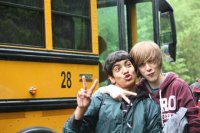How Are Happiness and Learning Connected?
We've all heard of the fight or flight response. We go into survival mode when threatened by something or someone. We either put up our dukes (literally or metaphorically) or take off running (literally or metaphorically). Students often go into survival mode when they feel threatened by an overwhelming cognitive task or confusing text, or when they are called on and don't know the answer, or are confronted or teased by another student (or a teacher!) Can one even learn in such a setting?
It's a question that deserves our full consideration.
As teachers, we also know that when students' affective filters or defenses are sky high, fight or flight responses will be modus operandi. A room full of defensive behaviors (withdrawn, angry) is a sad, unproductive place to teach and learn.
Now let's flip it and take a look at how much more we are able to learn when we are in harmony with the people and things in any given educational environment. Being in harmony means feeling safe, feeling valued and a necessary part a group, and in this case, a learning community.
Hearts and Minds in Sync
What does research show to be the opposite of the brain's fight or flight response? It shows that when we don't feel threatened at all, we have a willingness to be vulnerable, to be open to new ideas and guidance from others -- the ideal learning scenario!
Co-founder of the NeuroLeadership Institute Dr. David Rock says this:
"Engagement is a state of being willing to do difficult things, to take risks, to think deeply about issues and develop new solutions. ...Interest, happiness, joy, and desire are approach emotions. This state is one of increased dopamine levels, important for interest and learning."
Unfortunately, the hyper focus on standardized testing has gravitated many public schools so very far away from whole-child teaching and learning. Less time is spent on social-emotional, behavioral activities that help create and sustain an inviting and engaging classroom environment. And we know that to engage students in deeper learning -- those times we really stretch their thinking -- there is a certain vulnerability they must surrender to. It's a magical mix of willingness and curiosity. So how do we get them there?
Let's go back to Dr. David Rock:
"There is a large and growing body of research which indicates that people experiencing positive emotions perceive more options when trying to solve problems, solve more non-linear problems that require insight, [and they] collaborate better and generally perform better overall."
In the Classroom
Of course this is great news from the research of Dr. Rock and others. So before challenging students with those high-level cognitive demands such as problem-solving, we need to cultivate a safe and harmonious learning environment that invites vulnerability and genuine inquiry. Here are a few essentials for doing that:
Essential #1: Be Sure to Community Build All Year Long. Routinely include strategies and activities in your lessons, such as Save the Last Word for Me, that allow students to express who they are, their thoughts and ideas, build relationships, and practice collaboration. This will help grow and maintain a feeling of emotional and intellectual safety in your classroom.
Essential #2: Design Group Guidelines Together. We have all felt fear (or some anxiety) when working in a group: Will they like me? Will my contributions be valued? It's important students have a say when creating the guidelines so they feel connected to and ownership of them. They will also be more on board with adhering to them. "One Speaker at a Time," "Respect all Ideas," "Listen With Your Whole Body" are valuable norms when students collaborate. Make suggestions but let them decide on wording for the norms.
Essential #3: Have Non-Negotiables. Along with classroom rules and procedures, students must know non-negotiables right out the gate. My biggest non-negotiable: name-calling. This resulted in an immediate consequence (a call to the Dean and/or removal from the classroom that day). We have to tackle such things as name-calling and teasing head on or else kids won't feel safe to be themselves, let alone learn.
Essential #4: Post Student Work Everywhere. This one is simple and easy. When displays of essays, poems, projects, and exams dominate the walls, there is a sense of belonging for the students in the room. When they look around and see their own writing and thinking, they certainly experience a higher level of comfort than if they see store-bought posters. That said, if informational posters are needed, ask your students to create them.
Now we'd love to hear from you! How have you developed your classroom to be an inviting, safe, and productive place to learn? Please share in the comment section below.
